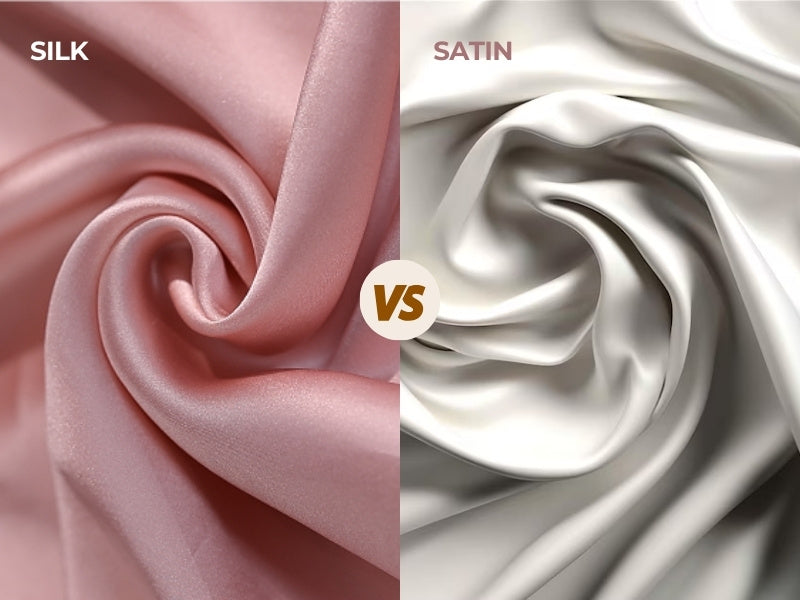How is silk made?
Silk is used in many industries, for example in the manufacture of clothing, furnishings, and parachute material. Silk is also widely used in medicine and surgery, as it's the perfect material for stitching and securely closing wounds, and is also naturally antibacterial. Silk is often used for silk sleepwear and silk bedding. However, it also works well for blouses and is very popular with underwear manufacturers.

The process of silk production requires seven different functions and begins with the harvesting of the cocoons from the silkworms. This must be done under very high heat so that the worms don't hatch from the cocoons. Second, the loose end of the cocoon must be identified so it can be unraveled. In some plants, a machine is used to thread it into the eye of the spooling machine; in others, this process is still done by human hands. Each time a cocoon is loaded for untangling, it's joined to the previous one to create a long, continuous piece of silk thread.
In the next step, the long threads are twisted together to form the yarn. It'll be quite uneven at this stage, so it must be passed through a roller to get the same thickness everywhere. Now the raw yarn can be dyed, and silk is made in many vibrant colors. It can also be bleached to white fabric. Once the silk is wound into the newly dyed balls, it can be woven into cloth, fabric or directly into a garment.
![[Light Blue] SilkSilky Pure Silk Notch Collar Women's Pajamas 001,](http://silksilky.com/cdn/shop/files/ab83afb9301666ee2f174a8ae72ffda4_4e9bb488-7880-40fe-9e69-f0fd823857c5.jpg?v=1764653199&width=1200)
![[Light Blue] SilkSilky Pure Silk Notch Collar Women's Pajamas 002,](http://silksilky.com/cdn/shop/files/db8dbeee5354fe3b631b963715847ffe.jpg?v=1764653202&width=1200)
![[Dark Red] SilkSilky Pure Silk Notch Collar Women's Pajamas 001,](http://silksilky.com/cdn/shop/files/599ed0811e1a5fcfa55bdc80a0279704_2643c850-a793-4475-a52b-7fef1bbd7e36.jpg?v=1762233837&width=1200)
![[Dark Red] SilkSilky Pure Silk Notch Collar Women's Pajamas 002,](http://silksilky.com/cdn/shop/files/9e022d4dd4f99aed4af8da3f58fcfd5b_efb9bafe-3d71-4283-9b81-e339ff08f352.jpg?v=1762233837&width=1200)
![[White] SilkSilky Pure Silk V Neck Nightgown 001,](http://silksilky.com/cdn/shop/files/a8ae95260a57844b1e2e00c4fcfabdcc_b922b270-af10-4e96-9493-0d877bd663db.jpg?v=1764140639&width=1200)
![[White] SilkSilky Pure Silk V Neck Nightgown 002,](http://silksilky.com/cdn/shop/files/24ac506750f8c38c51bb5b6d0ee15287.jpg?v=1764140639&width=1200)
![[Pink] SilkSilky Pure Silk Sleep Cap 001,](http://silksilky.com/cdn/shop/files/SilkSilky_Pure_Silk_Sleep_Cap_Pink_001_C-250529006.jpg?v=1762221980&width=1200)
![[Pink] SilkSilky Pure Silk Sleep Cap 002,](http://silksilky.com/cdn/shop/files/SilkSilky_Pure_Silk_Sleep_Cap_Pink_002_C-250529006.jpg?v=1762221980&width=1200)
![[Steel Blue] SilkSilky Pure Silk Notch Collar Women's Pajamas 001,](http://silksilky.com/cdn/shop/files/05b358f92fb5d252122b00d69a2fcfc5_88211a42-88c4-4448-8cb3-5f18529bfef8.jpg?v=1762237226&width=1200)








